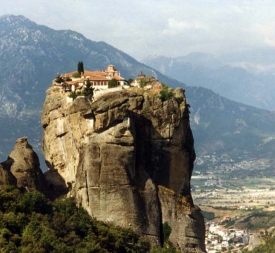
April Editorial
Meteora

April Editorial
Meteora
|
|
Meteora is near the city of Trikkala, ancient Trikki, birthplace of Asclepius, a small distance from the Pindos mountain range, in the Kalambaka valley. The Meteora is a collection of rocks which some refer to as "the Stone Forest". The average height of these rocks is about 300 meters with the highest being 1000 m. Taken together these rocks create a breathtaking landscape. The Meteora is definitly one of the most beautiful areas of Greece. How this rock formation came about is still a mystery with many theories being put forward. The most accepted one was put forward by the German geologist Philipson in the 19th century. His theory is based on the assumption that millions years ago there was a large river estuary in this area. Over millions of years mountains of stones, soil and other matter accumulated in the delta. This was combined with a major geological change about 25-30 million years ago which resulted in the landmass of central Europe being significantly lifted. Because of this shift, the inland sea fed by the estuary began to empty into what is now the Aegean Sea. As the water receded, enormous rocks began to break off of the mountains and fell down into the Thessalian basin. Millions of years of continuous corrosion from wind, rain, and earthquakes have sculpted the rock peaks into what they are today. This erosion has turned the rocks into sheer, slippery towers which appear to be unscalable. What makes these rocks even more remarkable today is their inhabitants – monks. During 14th and 15th centuries, 24 monastries have been built here, six of which are still open today. The Great Meteoron (seen on the picture, also known as Megalo Meteora) is the largest monastery in the group and is open to visitors. |
| _______________________________ | ||||
| Home | | | Shopping | | | Database |
© Biscuit Software 2004-2015
All rights reserved